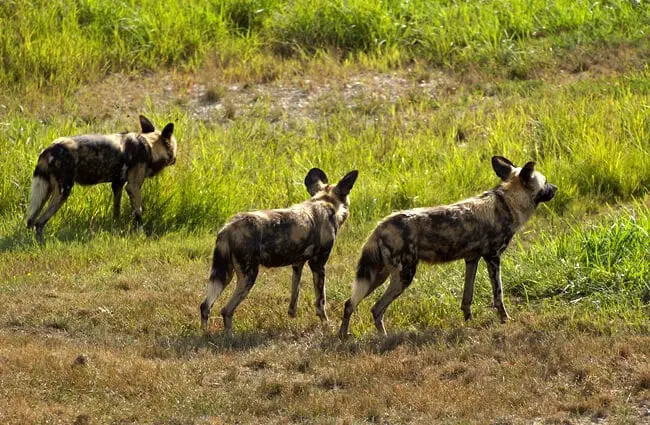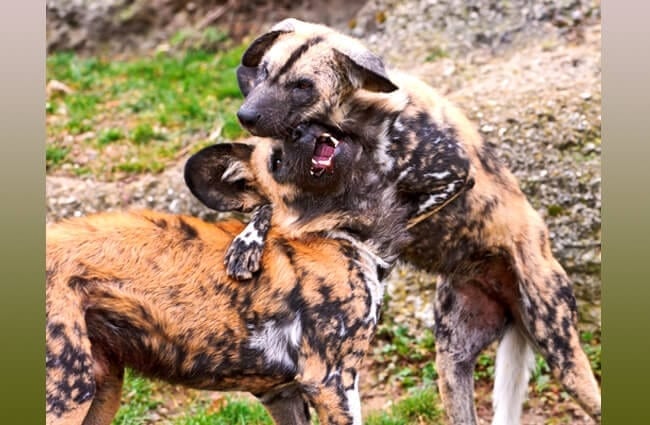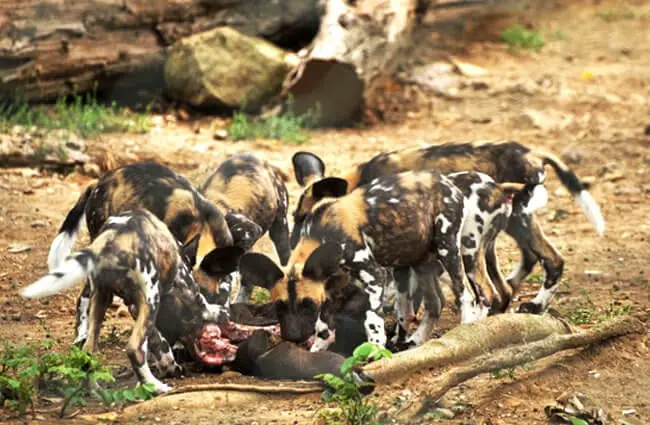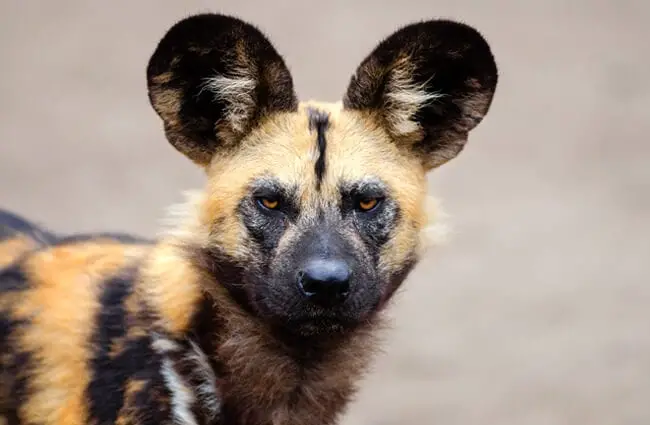The Painted Wolf: A Deep Dive into the World of African Wild Dogs
Often called painted wolves or African hunting dogs, Lycaon pictus is a fascinating and highly social carnivore native to sub-Saharan Africa. These remarkable animals, despite their striking appearance and complex social structures, face significant threats to their survival. This guide delves into all aspects of their lives, from evolutionary history to behavior, habitat, and conservation status.

I. Evolutionary History and Taxonomy
The African wild dog is not closely related to wolves, jackals, or coyotes, despite superficial similarities. Genetic studies reveal that they represent a unique lineage within the Canidae family, diverging from other canids around 4–5 million years ago. Their evolutionary path has led to specialized adaptations for endurance hunting and a highly cooperative social structure.
Fossil evidence is scarce, but indicates that their ancestors likely had a wider distribution in Africa before becoming restricted to the continent. The name Lycaon pictus reflects their mottled coat, with “lycaon” deriving from the Greek word for wolf and “pictus” meaning painted.
II. Physical Characteristics and Adaptations
African wild dogs are easily recognizable by their large, rounded ears, long legs, and distinctive, irregular coat patterns. Each individual’s markings are unique, much like human fingerprints. Their coat blends black, brown, yellow, and white, providing excellent camouflage in the African savanna and woodlands.
Adults typically weigh between 18 and 30 kilograms and stand approximately 60 to 75 centimeters tall at the shoulder. They possess powerful jaws and teeth adapted for tearing flesh, and their long legs enable them to cover considerable distances during hunts. Their relatively small body size, compared to other large African predators, contributes to their endurance and allows them to pursue prey relentlessly.
III. Habitat and Distribution
Historically, African wild dogs ranged throughout much of sub-Saharan Africa. Today, their distribution is fragmented and restricted to areas with sufficient prey and minimal human interference. They primarily inhabit savanna, woodland, and open grassland ecosystems.
Key populations are found in southern Africa, including Botswana, Tanzania, Zimbabwe, and South Africa. Smaller, isolated populations exist in other regions, such as Zambia and Mozambique. They require large home ranges, often exceeding 200 square kilometers, to support their pack size and hunting needs.
IV. Diet and Hunting Strategies
African wild dogs are carnivores, and their diet consists primarily of medium to large ungulates, such as impala, gazelle, wildebeest, and zebra. They are renowned for their cooperative hunting strategies, which are among the most effective in the animal kingdom.

Hunts typically involve the entire pack, with individuals coordinating their efforts to pursue, encircle, and ultimately bring down their prey. They are known for their relentless pursuit and ability to exhaust their targets. Unlike lions or leopards, they rarely scavenge, preferring to hunt fresh kills. Their success rate is remarkably high, often exceeding 70 percent, which is significantly higher than that of most other large African predators.
V. Social Structure and Reproduction
African wild dogs live in packs, which are typically led by a dominant breeding pair – an alpha male and alpha female. The pack consists of their offspring from various litters, creating a highly cooperative and complex social structure. All members of the pack contribute to raising the pups, sharing food and protecting them from predators.
Breeding is not strictly seasonal, but usually peaks during the rainy season when prey is more abundant. Females typically give birth to a litter of two to seven pups in a den, which is often an abandoned aardvark burrow. Pups are born blind and helpless and rely entirely on their mother and other pack members for care.
Cooperative pup rearing is a defining characteristic of African wild dog society. All adults regurgitate food for the pups and provide protection, increasing their chances of survival. This level of cooperation is rare among social carnivores.
VI. Ecological Role and Interactions with Other Species
As apex predators, African wild dogs play a vital role in maintaining the health and balance of their ecosystems. They help to regulate prey populations, preventing overgrazing and promoting biodiversity. Their hunting strategies also influence the behavior and distribution of other predators.

They often compete with lions, hyenas, and other predators for prey. While they can sometimes successfully defend their kills, they are often forced to abandon them to larger or more aggressive competitors. They also interact with various other species, including birds and mammals, which may benefit from their scavenging activities or receive protection from their presence.
VII. Conservation Status and Threats
African wild dogs are currently listed as endangered by the International Union for Conservation of Nature (IUCN). Their populations have declined dramatically over the past few decades due to a combination of factors, including habitat loss, human wildlife conflict, disease, and fragmentation.
Habitat loss and fragmentation are major threats, as they reduce the availability of prey and restrict the movement of packs. Human wildlife conflict arises when wild dogs prey on livestock, leading to retaliatory killings by farmers. Diseases such as rabies and canine distemper can decimate populations. Additionally, genetic bottlenecks resulting from small, isolated populations can reduce their adaptability and increase their vulnerability to extinction.
VIII. Human Interactions and Safety
Encounters between humans and African wild dogs are relatively rare, but can occur, especially in areas where their habitat overlaps with human settlements. If you encounter a pack of wild dogs, it is crucial to remain calm and avoid making sudden movements. Do not approach them, and maintain a safe distance. Slowly back away while making eye contact. Never run, as this may trigger a chase response.

Reporting sightings to local wildlife authorities can help them monitor populations and implement conservation measures. Supporting conservation organizations that work to protect African wild dogs is also essential.
IX. African Wild Dogs in Captivity
Caring for African wild dogs in captivity requires a deep understanding of their complex social needs and natural behaviors. They thrive in large, spacious enclosures that allow for ample exercise and social interaction. Enclosures should be designed to mimic their natural habitat, with varied terrain, shade, and enrichment items.
Providing a varied diet that replicates their natural prey is essential. Zookeepers should focus on offering whole prey items whenever possible to promote natural foraging behaviors. Social grouping is crucial; ideally, wild dogs should be housed in established packs to maintain their social structure and minimize stress. Regular veterinary checkups and preventative healthcare are essential to ensure their health and well-being.
X. Fascinating Facts
Here are a few surprising facts about African wild dogs:
- They are also known as painted wolves due to their colorful coats.
- They have incredibly large ears which help them dissipate heat and locate prey.
- They communicate using a complex system of vocalizations, body language, and scent marking.
- They are renowned for their stamina and can run for long distances at speeds of up to 60 kilometers per hour.
- Pups are often fed meat brought back from the hunt by the entire pack.

The future of African wild dogs depends on continued conservation efforts. By understanding their unique biology, behavior, and ecological role, we can work toward ensuring their survival for generations to come.

![Red Angus Closeup of a beautiful Red Angus cowPhoto by: U.S. Department of Agriculture [pubic domain]https://creativecommons.org/licenses/by/2.0/](https://animals.net/wp-content/uploads/2020/03/Red-Angus-4-238x178.jpg)




![Red Angus Closeup of a beautiful Red Angus cowPhoto by: U.S. Department of Agriculture [pubic domain]https://creativecommons.org/licenses/by/2.0/](https://animals.net/wp-content/uploads/2020/03/Red-Angus-4-100x75.jpg)

